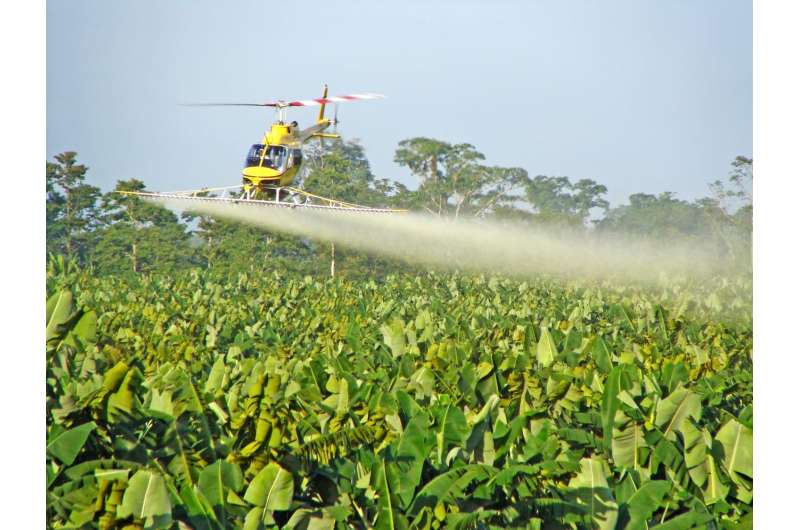Sequencing of fungal disease genomes may help prevent banana armageddon

Researchers at the University of California, Davis, and in the Netherlands have discovered how a group of three closely related fungal pathogens have evolved into a lethal threat to the world's bananas, whilst an international consortium led by scientists from Wageningen UR (University & Research Centre) has unravelled the DNA of the fungus that causes black Sigatoka disease in bananas. The findings provide leads for increasing the sustainability of banana cultivation, for instance through the development of a resistant banana plant. Both studies were published in PLOS Genetics on August 11.
The Sigatoka group of fungi
The Sigatoka disease complex is a cluster of three closely related fungi—yellow sigatoka (Pseudocercospora musae), eumusae leaf spot (Pseudocercospora eumusae) and black sigatoka (Pseudocercospora fijiensis)—which emerged in quick succession during the last century as destructive pathogens on banana.
Yellow sigatoka was the first of the three to be recorded on banana, although eumusae leaf spot and black sigatoka are now the most devastating, with black sigatoka posing the greatest constraint to banana production worldwide. Black sigatoka is air-borne and affects the leaves of banana plants in small and large-scale plantations, and without chemical control it results in huge yield losses. The disease also reduces the quality of the fruit, causing premature ripening. The Cavendish banana, the most commonly grown banana variety worldwide, is especially susceptible to the black Sigatoka fungus. Because Cavendish banana plants are genetically uniform, a disease capable of killing one plant could kill them all.
DNA sequence offers possibilities for disease control
Gert Kema, Professor in Tropical Phytopathology at Wageningen University and banana expert explains: "Black Sigatoka has a huge social, ecological and economic impact worldwide. Thanks to the sequencing of the DNA of the Pseudocercospora fungus we are now gaining a greater insight into the interaction between the fungus and the banana plant. This provides us with leads for increasing the sustainability of banana cultivation, making it better for the environment, the local population and the economy. For example, the insights offer us opportunities to develop a banana plant that is suitable for production and export, and which is also resistant against black Sigatoka."
This fresh understanding of the DNA of the black Sigatoka fungus is also providing new information that is useful in the development of more effective and, hopefully, less environmentally unfriendly crop protection products. This could reduce the amount of fungicide spraying which, in turn, would improve the quality of life of the people working in the plantations and those who live in the immediate surroundings.
Bananas and the disease threat
The banana is the world's leading fruit crop and ranks fourth as a global staple food, with 140 million tons of bananas produced annually in subtropical and tropical regions. Bananas, however, are prone to many diseases that can severely reduce production, posing a threat to global food security.
The fruit also suffers from an "image problem," giving consumers the appearance that it is and always will be readily available, UC Davis molecular plant pathologist Ioannis Stergiopoulos said. In reality, the global banana industry could be wiped out in just five to 10 years by fast-advancing fungal diseases. Already, the Sigatoka disease complex can reduce banana yields by 50-70%, if not controlled.
Managing the disease requires over 50 applications of fungicide per year, which is prohibitively expensive for smallholder farmers, who consequently are left to the mercy of the disease.
Probing the genomes for solutions
"We have discovered that the two more destructive pathogens share a pattern of parallel changes in their core metabolic pathways that enables them to exploit more efficiently the nutrient resources available in banana," said Stergiopoulos, who along with bioinformatician Ti-Cheng Chang, led the effort to sequence and analyze the fungal genomes of eumusae leaf spot and yellow sigatoka, comparing their findings with the previously sequenced black sigatoka genome sequence.
They discovered that eumusae leaf spot and black sigatoka become more lethal to banana plants not just by shutting down the plant's immune system but also by adapting their metabolism to better match that of the host plants, allowing them to more efficiently acquire and assimilate nutrients from the host.
"Now, for the first time, we understand the genomic basis of the evolution of virulence in these fungal diseases, thus giving us an opportunity for intervention," Stergiopoulos said.
More information: PLOS Genetics August 11, 2016. DOI: 10.1371/journal.pgen.1005876
Journal information: PLoS Genetics
Provided by Public Library of Science



















